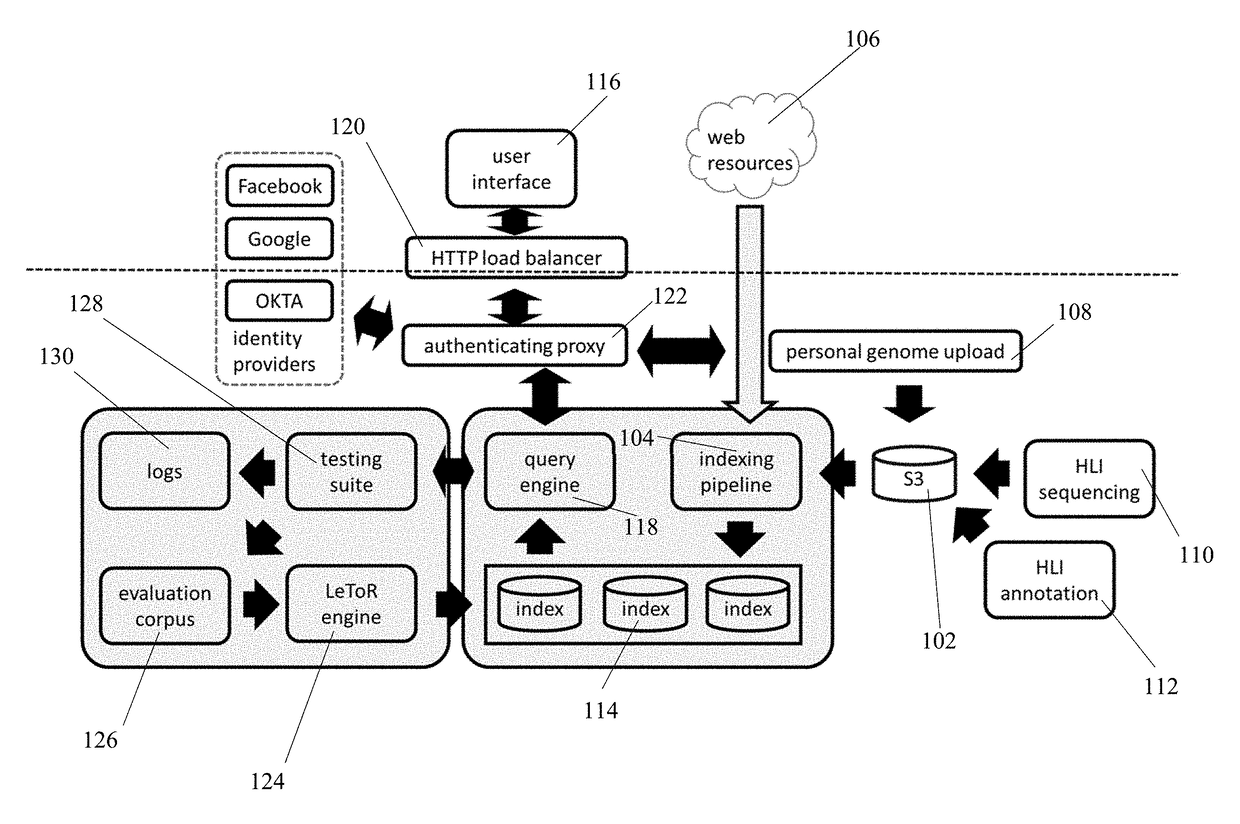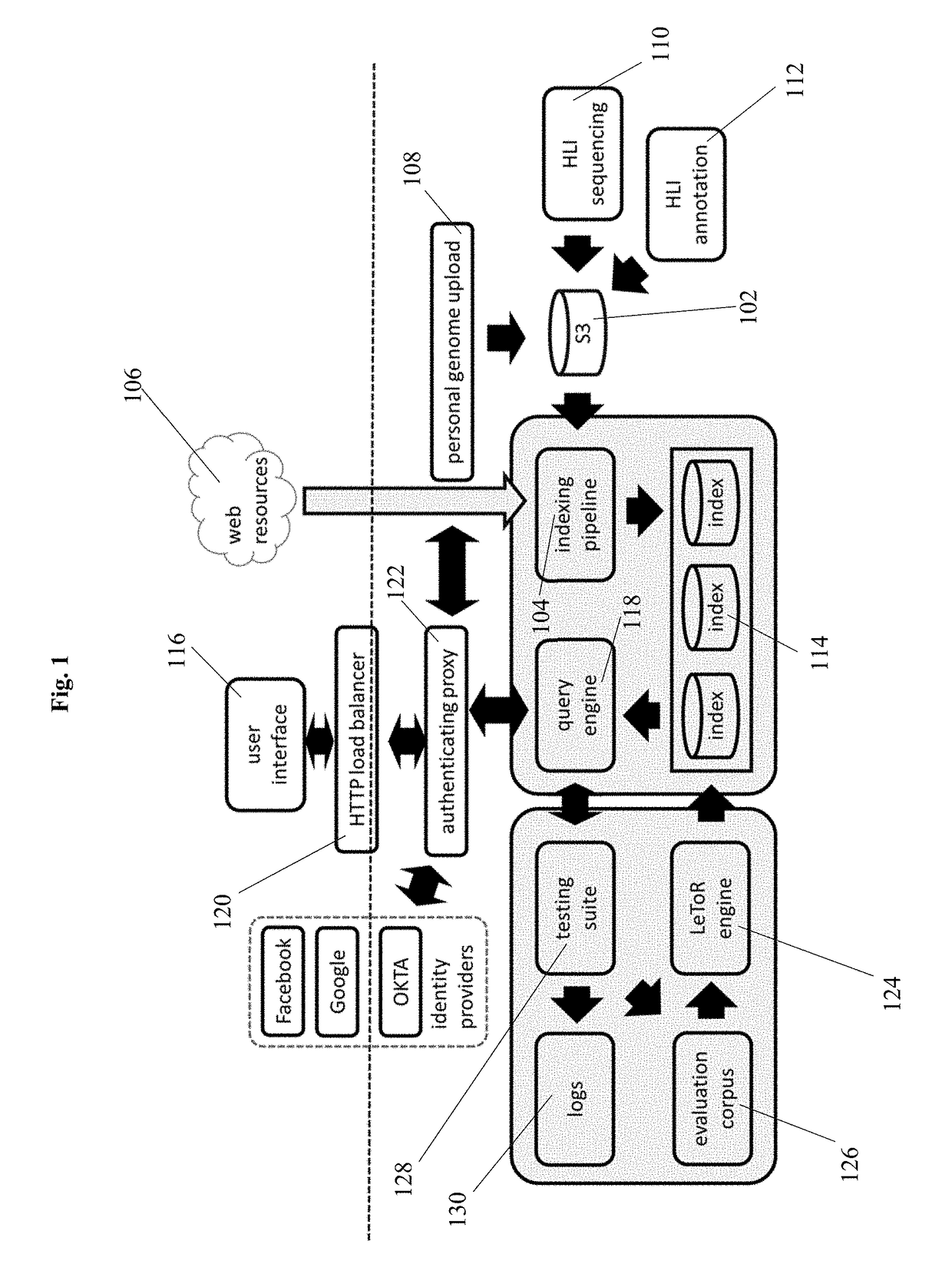Genomic, metabolomic, and microbiomic search engine
a search engine and metabolomic technology, applied in the field of genemic, metabolomic, and microbiomic search engines, can solve the problems of personal access to genomic information, multiple fatal flaws in current bioinformatic techniques, and sheer amount of information to search, and achieve poor validation, poor performance of ranking scoring and indexing algorithms, and high degree of sophistication
- Summary
- Abstract
- Description
- Claims
- Application Information
AI Technical Summary
Benefits of technology
Problems solved by technology
Method used
Image
Examples
example 1
l User-Centric Searches
[0124]A user who has had their entire genome sequenced, and uploaded may use the search engine to discover DNA sequence variants that may be involved with certain ancestor groups, geographic regions, or Homo sapiens subspecies. For example, a user might search for their user ID and Neanderthal or Denisovan in order to discover their percent ancestry from each Homo sapiens subspecies. Users may have permission only for certain user IDs such as their own, or a family member that specifically grants access. A user may be able to discover sequence variants that differ between father and child, mother and child, siblings, grandparents and grandchildren, or cousins. For example, “ABC12345-ABC67890” returns all novel variants between a son (ABC12345) and a father (ABC67890).
example 2
re Provider-Centric Searches
[0125]A health care provider treating a patient who has had their entire genome sequenced may use the search engine to discover DNA sequence variants that may be involved in disease risk. A health care provider may type in their patient's identification number and search for variants associated with disease. For example, the search string might be, “ABC12345 and known gene variants associated with diabetes,” which would return all variants that have been previously determined to play a role in diabetes by an orthogonal method such as GWAS. The provider may search for gene variants in genes that are known to play a role in diabetes, “ABC12345 and sequence variants in known genes associated with diabetes.” This search would return a list of sequence variants from the individual's sequence data that occur in a gene or near a gene that has previously shown involvement in diabetes from an orthogonal method such as mouse phenotyping. This may, for example, retu...
example 3
r-Centric Searches
[0126]A researcher will use data searches and information from the genomic search engine to discover new therapeutic targets. A researcher interested in hypertension may type in a string such as, “sequence variants associated with hypertension with a p value less than 0.0000001.” The search will return a list of variants with p-values ranked from lowest to highest within the specified range. A given gene with a role in hypertension may have more than one sequence variant associated. Therefore, the researcher may group sequence variants by gene and use a variety of methods to sort the resulting genes (e.g., most sequence variants normalized for gene length, most sequence variants above a certain significance threshold, sequence variants in highly conserved regions, sequence variants represented within certain demographic groups). For example, the researcher may then search within the given results for highly significant p-values for genes that have functional annota...
PUM
 Login to View More
Login to View More Abstract
Description
Claims
Application Information
 Login to View More
Login to View More - R&D
- Intellectual Property
- Life Sciences
- Materials
- Tech Scout
- Unparalleled Data Quality
- Higher Quality Content
- 60% Fewer Hallucinations
Browse by: Latest US Patents, China's latest patents, Technical Efficacy Thesaurus, Application Domain, Technology Topic, Popular Technical Reports.
© 2025 PatSnap. All rights reserved.Legal|Privacy policy|Modern Slavery Act Transparency Statement|Sitemap|About US| Contact US: help@patsnap.com



